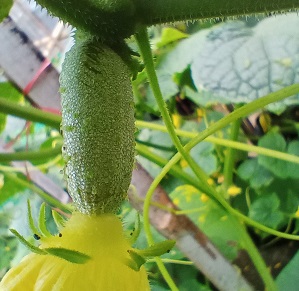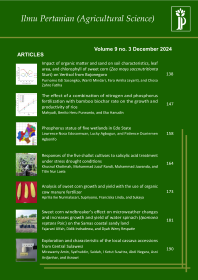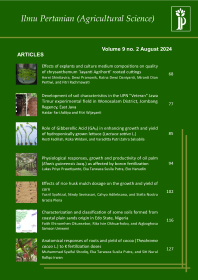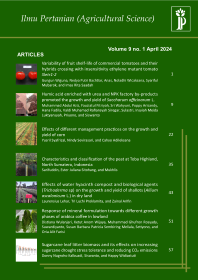
Effects of paclobutrazol concentrations and watering frequencies on the flowering ratio of cucumber plants (Cucumis sativus L.)
Ratih Hartono Putri(1*), Aziz Purwantoro(2), Valentina Dwi Suci Handayani(3), Dyah Weny Respatie(4)
(1) Department of Agronomy, Faculty of Agriculture, Universitas Gadjah Mada Jln. Flora no. 1, Bulaksumur, Sleman, Yogyakarta 55281, Indonesia
(2) Department of Agronomy, Faculty of Agriculture, Universitas Gadjah Mada Jln. Flora no. 1, Bulaksumur, Sleman, Yogyakarta 55281, Indonesia
(3) Department of Agronomy, Faculty of Agriculture, Universitas Gadjah Mada Jln. Flora no. 1, Bulaksumur, Sleman, Yogyakarta 55281, Indonesia
(4) Department of Agronomy, Faculty of Agriculture, Universitas Gadjah Mada Jln. Flora no. 1, Bulaksumur, Sleman, Yogyakarta 55281, Indonesia
(*) Corresponding Author
Abstract
Generally, cucumber plants have more male flowers than female flowers. The fewer number of female flowers is one of the problems of cucumber production. Flowering regulation can be performed by applying growth regulators and water management. The study aims to determine the effects of paclobutrazol concentrations and watering frequencies on the flowering ratio of cucumber plants. The experiment was arranged in a factorial Randomized Completely Block Design at the Agricultural, Food, and Fishery Extension Center, Seyegan, Yogyakarta. The first factor was the paclobutrazol concentrations consisting of four levels (a control, 0.187 mL.L-1, 0.375 mL.L-1, and 0.562 mL.L-1). Meanwhile, the second factor was the watering frequency consisting of three levels (once a day, once every two days, and once every three days). The observed data were performed using the analysis of variance (ANOVA) and followed with Duncan’s Multiple Range Test at α= 5 %. The paclobutrazol concentrations resulted in a significant effect on all of the observed variables. Meanwhile, watering frequencies showed no significant effect on the male flowers, female flowers and ratio of male to female flowers in cucumber. There was an interaction effect of paclobutrazol concentration and watering frequency on the plant height and flowering age of cucumber plants. The treatment of paclobutrazol at a concentration of 0.375 mL.L-1, decreased of male flowers and increased of female flowers, reducing the ratio of male and female flowers of cucumber plants at various watering frequencies.
-1
Keywords
Full Text:
PDFReferences
Amalia, S. F. (2014). Aplikasi ethepon untuk meningkatkan pembentukan bunga dan buah mentimun (Cucumis sativus L.). Thesis. Faculty of Agriculture. Institut Pertanian Bogor. Bogor.
Balai Penelitian Tanaman Sayuran. (2013). Budidaya mentimun. [online]. Available at: https://balitsa.litbang.pertanian.go.id/ind/images/Isi%20poster/MP03%20Budidaya%20mentimun.pdf. [Accesed 15 September 2020].
Budiyanto, Hajoeningtijas, O. D. and Nugroho, B. (2010). Pengaruh pemangkasan cabang dan kadar paklobutrazol terhadap hasil mentimun (Cucumis sativus L.). Agritech, 12(2), 100–113.
Desta, B. and Amare, G. (2021). Paclobutrazol as a plant growth regulator. Chemical and Biological Technologies in Agriculture, 8(1), pp. 1-15.
Flores, L. L. C., Alcaraz, T. D. J. V., Ruvalcaba, L. P., Valdés, T. D., Tafoya, F. A., Torres, N. D. Z., and Juárez, M. G. Y. (2018). Paclobutrazol applied on cotyledonal leaves and quality of cucumber, squash, melon and watermelon seedlings. Agricultural Sciences, 9(03), pp. 264-271.
Gerdakaneh, M., Hoseini, F., and Eftekharinasab, N. (2018). Effect of paclobutrazol and naa on sex determination and seed yield of medicinal pumpkin (Cucurbıta pepo L.). International Journal of Horticultural Science and Technology, 5(2), pp. 209–217.
Hua, S., Zhang, Y., Yu, H., Lin, B., Ding, H., Zhang, D., and Fang, Z. (2014). Paclobutrazol application effects on plant height seed yield and carbohydrate metabolism in canola. International Journal of Agriculture and Biology, 16(3), pp. 471-479.
Liu, F., Jensen, C. R., and Andersen. M. N. (2004). Drought stress effect on carbohydrate concentration in soybean leaves and pods during early reproductive development: its implication in altering pod set. Field Crops Research. 86(1), pp. 1-13.
Kamran, M., Cui, W., Ahmad, I., Meng, X., Zhang, X., Su, W., and Liu, T. (2018). Effect of paclobutrazol, a potential growth regulator on stalk mechanical strength, lignin accumulation and its relation with lodging resistance of maize. Plant growth regulation, 84(2), pp. 317-332.
Kementerian Pertanian. (2009). Lampiran Keputusan Menteri Pertanian. [online]. Available at: https://varitas.net/dbvarietas/deskripsi/4098.pdf. [Accesed 5 September 2020].
Kumar, S., Ghatty, S., Satyanarayana, J., Guha, A., Chaitanya, B. S. K., and Reddy, A. R. (2012). Paclobutrazol treatment as a potential strategy for higher seed and oil yield in field-grown Camelina sativa L. crantz. BMC Research Notes, 5, 137.
Lolaei, A., Mobasheri, S., Bemana, R., and Teymori, N. (2013). Role of paclobutrazol on vegetative and sexual growth of plants. International Journal Agriculture and Crop Science, 5(9), pp. 958–961.
Maimunnah, Rusmayadi, G., and Langai, B.F. (2018). Pertumbuhan dan hasil dua varietas tanaman kedelai (Glycine max L.) dibawah kondisi cekaman kekeringan pada berbagai stadia tumbuh. Enviro Scienteae. 14(3), pp. 211-221.
Nonami, H. (1998). Plant water relations and control of cell elongation at low water potentials. Journal of Plant Research. 111, pp. 373-382.
Nugroho, P.T. (2012). Pengaruh paclobutrazol dan komposisi larutan pulsing terhadap kualitas pasca panen bunga matahari (Helianthus annuus L.) sebagai bunga potong. Thesis. Department of Agronomy and Horticulture. Institut Pertanian Bogor. Bogor.
Pan, J., Wang, G., Wen, H., Du, H., Lian, H., He, H., Pan, J., and Cai, R. (2018). Differential gene expression caused by the F and M loci provides insight into ethylene-mediated female flower differentiation in cucumber. Frontiers in Plant Science, 9, 1091.
Pokawattana, T., Gruneck, L., Seesangboon, A., Eungwanichayapant, P. D., Tovaranonte, J., and Popluechai, S. (2018). Effect of paclobutrazol on flower development and gene expression of jatropha. Chiang Mai Journal of Science, 45(3), pp. 1323-1334.
Rahayu, R. S., Poerwanto, R., Efendi, D., and Widodo, W.D. (2020). Cekaman kekeringan berat mempengaruhi keberhasilan induksi bunga jeruk keprok madura. J. Hort. Indonesia. 11(1), pp. 13-23.
Sewoong An., Park, S.W., and Kwack Y. (2020). Growth of cucumber scions, rootstocks, and grafted seedlings as affected by different irrigation regimes during cultivation of ‘joenbaekdadagi’ and ‘heukjong’ seedlings in a plant factory with artificial lighting. Journal Agronomy. 10(12). pp. 1-17.
Sudrajat, A., Frasetya, B and Daniswara, F.G. (2021). Application of paclobutrazol and electrical conductivity value of nutrient solutions to improve yield and quality Cucumis sativus L. var Japanese on the hydroponic system. IOP Conf. Series: Materials Science and Engineering. 1098, pp. 1-5.
Suryana. (2012). Pengaruh konsentrasi paklobutrazol dan dosis pupuk P pada pertumbuhan dan hasil kacang tanah (Arachis hypogeaea l.). Undergraduated Thesis. Universitas Gadjah Mada. Yogyakarta.
Susilawati, Suwignyo, R.A., Munandar, Hasmeda, M. (2012). Karakter agronomi dan fisiologi varietas cabai merah pada kondisi cekaman genangan. Jurnal Agronomi Indonesia. 40(3), pp. 196–203.
Tesfahun, W. (2018). A review on: response of crops to paclobutrazol application. Cogent Food & Agriculture, 4(1), pp. 1-9.
Watson, G. and Jacobs, K. (2012). Control of apple scab and cytospora canker with paclobutrazol. Journal Arboriculture snd Urban Forestry, 38(3), pp. 112–116.
Widyan, E. and Dewi, K. (2008). Respon fisiologis tanaman tomat (Lycopersicum esculentum Mill. cv. Tomat Kaliurang) terhadap aplikasi pupuk NPK dan paklobutrazol. Thesis. Universitas Gadjah Mada.
Yadava. LP. (2012). Effect off growth retardants on floral biology, fruit set, and fruit quality of cape gooseberry (Physalis peruviana L.). American Journal of Plant Physiology. 7(3), pp. 143-148.
Zhang, T., Li, X., Yang, Y., Guo, X., Feng, Q., Dong, X., & Chen, S. (2019). Genetic analysis and QTL mapping of fruit length and diameter in a cucumber (Cucumis sativus L.) recombinant inbred line (ril) population. Scientia Horticulturae, 250 (1), pp. 214–222.
Article Metrics
Refbacks
- There are currently no refbacks.
Ilmu Pertanian (Agricultural Science) ISSN 0126-4214 (print), ISSN 2527-7162 (online) is published by Faculty of Agriculture Universitas Gadjah Mada collaboration with Perhimpunan Sarjana Pertanian Indonesia (PISPI) and licensed under a Creative Commons Attribution-ShareAlike 4.0 International License.














